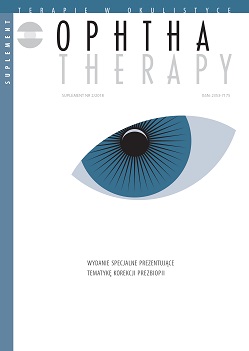Refrakcyjna wymiana soczewki a laserowa chirurgia refrakcyjna w prezbiopii. Kogo i dlaczego kwalifikować?
##plugins.themes.bootstrap3.article.main##
Abstrakt
Prezbiopia jest problemem dotykającym większość populacji powyżej 40. r.ż. i niemal wszystkie osoby po 50. r.ż. Chirurgia refrakcyjna opierająca się na zabiegach na rogówce lub soczewce przynosi rozwiązania tego problemu. Metody laserowej chirurgii refrakcyjnej rogówki mające dłuższą historię wiążą się z pewnymi kompromisami koniecznymi do leczenia utraty akomodacji. Obecnie bardziej satysfakcjonujące rozwiązanie tego problemu stanowi chirurgia refrakcyjna stosująca zabiegi na soczewce przy użyciu soczewek wieloogniskowych. Kluczem do osiągnięcia sukcesu pooperacyjnego jest bardzo staranny dobór pacjentów. Doświadczenia własne związane z zastosowaniem wieloogniskowych soczewek AcrySof® IQ PanOptix® i PanOptix Toric® firmy Alcon wskazują, że jest to najlepsze obecnie rozwiązanie problemu starczowzroczności.
Pobrania
##plugins.themes.bootstrap3.article.details##

Utwór dostępny jest na licencji Creative Commons Uznanie autorstwa – Użycie niekomercyjne – Bez utworów zależnych 4.0 Międzynarodowe.
Copyright: © Medical Education sp. z o.o. License allowing third parties to copy and redistribute the material in any medium or format and to remix, transform, and build upon the material, provided the original work is properly cited and states its license.
Address reprint requests to: Medical Education, Marcin Kuźma (marcin.kuzma@mededu.pl)
Bibliografia
2. Alarcon A, Anera RG, Jimenez del Barco L et al. Designing multifocal corneal models to correct presbyopia by laser ablation. J Biomed Opt. 2012; 17(1): 1-9.
3. Mrochen M. Hyperprolate corneas for pseudo-presbyopia correction. Cataract Refr Surg Today Eur. 2009; 4(1): 28-9.
4. Reinstein DZ, Carp GI, Archer TJ et al. LASIK for the correction of presbyopia in emmetropic patients using aspheric ablation profiles and a micro-monovision protocol with the Carl Zeiss Meditec MEL80 and VisuMax. J Cataract Refr. Surg. 2012; 28: 531-41.
5. Taneri S, Oehler S. Keratectasia after treating presbyopia with INTRACOR followed by SUPRACOR enhancement. J Cataract Refr Surg. 2013; 29: 573-6.
6. Yılmaz OF, Alagöz N, Pekel G et al. Intracorneal inlay to correct presbyopia: Long-term results. J Cataract Refr Surg. 2011; 37(7): 1275-81.
7. Dexl AK, Seyeddain O, Riha W et al. One-year visual outcomes and patient satisfaction after surgical correction of presbyopia with an intracorneal inlay of a new design. J Cataract Refr Surg. 2012; 38(2): 262-69.
8. Braga-Mele R, Chang D, Dewey S et al. Multifocal intraocular lens: refractive indications and contraindications for implantation. J Cataract Refr Surg. 2014; 40: 313-22.
9. Bronicki D, Miller M, Dyda W et al. Pseudosoczewkowość po operacji zaćmy nie musi ograniczać. Soczewka trójogniskowa jako rozwiązanie problemu starczowzroczności. OphthaTherapy. 2015, 4(8): 286-91.
10. Lee BS, Chang DF. Comparison of the Rotational Stability of Two Toric Intraocular Lenses in 1273 Consecutive Eyes. Ophthalmology. 2018; 125(9): 1325-31.
11. Gundersen GK, Potvin R. Trifocal intraocular lenses: a comparison of the visual performance and quality of vision provided by two different lens designs. Clin Ophthalmol. 2017; 11: 1081-7.

